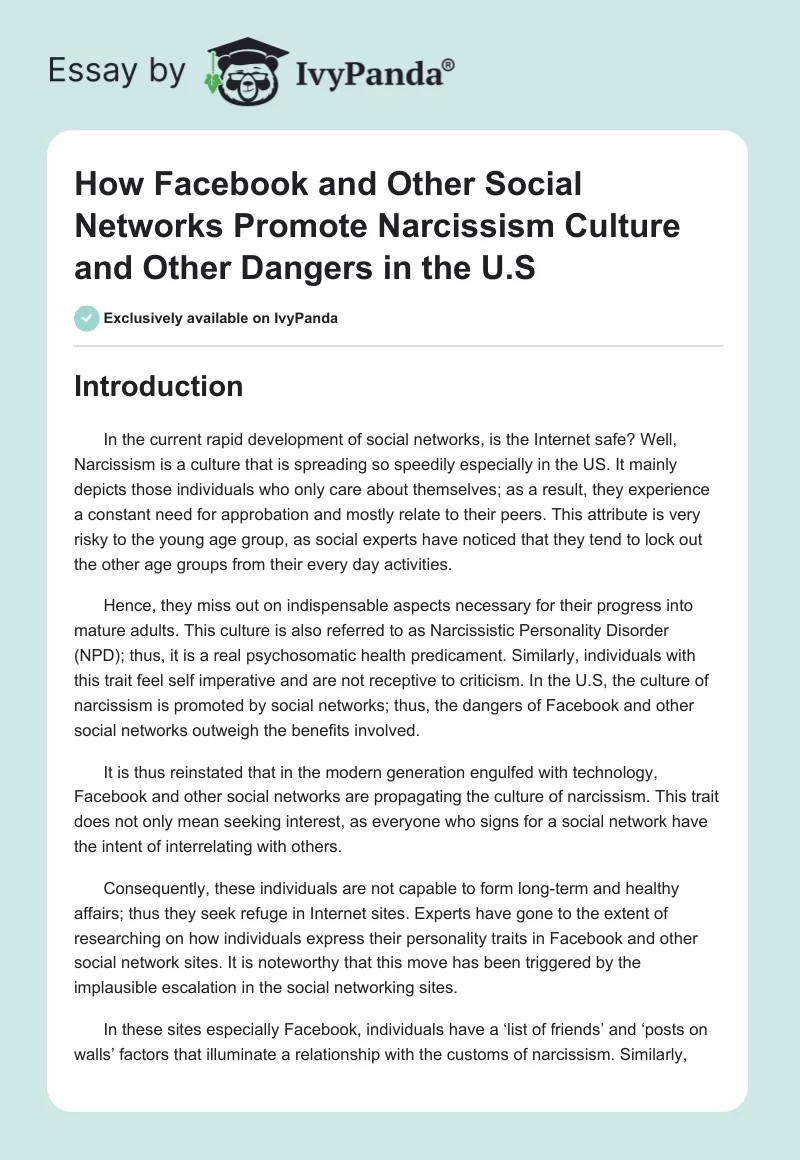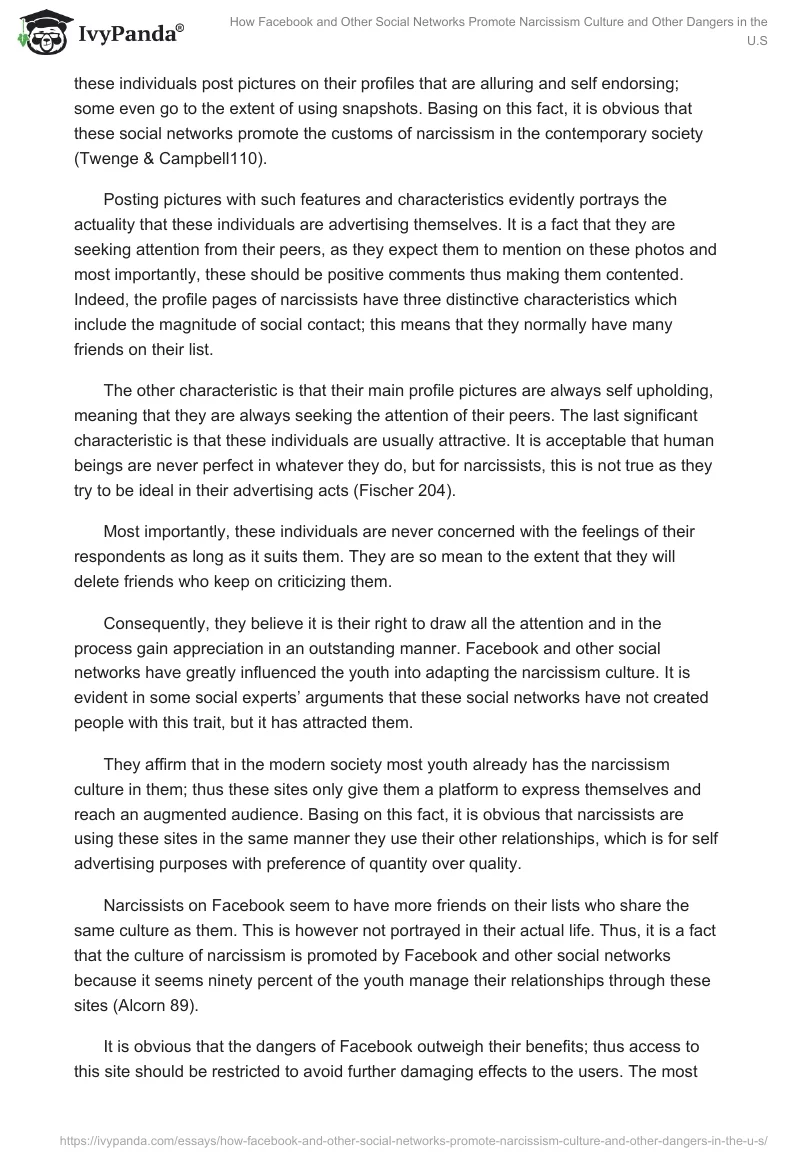Introduction
In the current rapid development of social networks, is the Internet safe? Well, Narcissism is a culture that is spreading so speedily especially in the US. It mainly depicts those individuals who only care about themselves; as a result, they experience a constant need for approbation and mostly relate to their peers. This attribute is very risky to the young age group, as social experts have noticed that they tend to lock out the other age groups from their every day activities.
Hence, they miss out on indispensable aspects necessary for their progress into mature adults. This culture is also referred to as Narcissistic Personality Disorder (NPD); thus, it is a real psychosomatic health predicament. Similarly, individuals with this trait feel self imperative and are not receptive to criticism. In the U.S, the culture of narcissism is promoted by social networks; thus, the dangers of Facebook and other social networks outweigh the benefits involved.
It is thus reinstated that in the modern generation engulfed with technology, Facebook and other social networks are propagating the culture of narcissism. This trait does not only mean seeking interest, as everyone who signs for a social network have the intent of interrelating with others.
Consequently, these individuals are not capable to form long-term and healthy affairs; thus they seek refuge in Internet sites. Experts have gone to the extent of researching on how individuals express their personality traits in Facebook and other social network sites. It is noteworthy that this move has been triggered by the implausible escalation in the social networking sites.
In these sites especially Facebook, individuals have a ‘list of friends’ and ‘posts on walls’ factors that illuminate a relationship with the customs of narcissism. Similarly, these individuals post pictures on their profiles that are alluring and self endorsing; some even go to the extent of using snapshots. Basing on this fact, it is obvious that these social networks promote the customs of narcissism in the contemporary society (Twenge & Campbell110).
Posting pictures with such features and characteristics evidently portrays the actuality that these individuals are advertising themselves. It is a fact that they are seeking attention from their peers, as they expect them to mention on these photos and most importantly, these should be positive comments thus making them contented. Indeed, the profile pages of narcissists have three distinctive characteristics which include the magnitude of social contact; this means that they normally have many friends on their list.
The other characteristic is that their main profile pictures are always self upholding, meaning that they are always seeking the attention of their peers. The last significant characteristic is that these individuals are usually attractive. It is acceptable that human beings are never perfect in whatever they do, but for narcissists, this is not true as they try to be ideal in their advertising acts (Fischer 204).
Most importantly, these individuals are never concerned with the feelings of their respondents as long as it suits them. They are so mean to the extent that they will delete friends who keep on criticizing them.
Consequently, they believe it is their right to draw all the attention and in the process gain appreciation in an outstanding manner. Facebook and other social networks have greatly influenced the youth into adapting the narcissism culture. It is evident in some social experts’ arguments that these social networks have not created people with this trait, but it has attracted them.
They affirm that in the modern society most youth already has the narcissism culture in them; thus these sites only give them a platform to express themselves and reach an augmented audience. Basing on this fact, it is obvious that narcissists are using these sites in the same manner they use their other relationships, which is for self advertising purposes with preference of quantity over quality.
Narcissists on Facebook seem to have more friends on their lists who share the same culture as them. This is however not portrayed in their actual life. Thus, it is a fact that the culture of narcissism is promoted by Facebook and other social networks because it seems ninety percent of the youth manage their relationships through these sites (Alcorn 89).
It is obvious that the dangers of Facebook outweigh their benefits; thus access to this site should be restricted to avoid further damaging effects to the users. The most conspicuous aspect that is worrying the parents and educators is racism and ethnicity. Social experts have noticed that many racism and ethnicity hate groups are common in Facebook, as a result; the users are exposed to the insensitivity of these aspects during their online conversations.
It is thus alarming when young people get exposed to the online interracial interaction. Indeed, some individuals who had the assumption that racism does not exist may go online and post insensitive comments about the issue. This might trigger conflict and hate speech among the users a fact that might lead to the sour relationships between different races in institutions or even countries (Twenge & Keith 78).
It is noteworthy that people who join Facebook and other social networks have different motives. There are those who have the intention of conducting criminal activities. Recent news indicate that involve crimes were committed with the help of such social networks.
For example, there was an incident in the news that revealed how a man lured a teenage female through Facebook and ended up raping her and finally killing her. Such cases can be avoided by limiting the time young people spend on Facebook. Additionally, it is advisable for users of such sites to ensure they only add people they personally know to their friend list (Fischer 205).
Research has revealed that addiction to Facebook and other social network sites results in diminished productivity at work. This occurs when majority of employees spend significant proportions of office hours in the social networks.
As a result, their concentration at work is affected leading to diminished quality of work. It is advisable that employees minimize or avoid these sites during working hours. On the same aspect, it is noticed that such sites can compromise security and privacy concerns of institutions. This is because employees can leak company trade secrets to competitors through such communication channels.
As a result, the benefiting company might experience large productivity because of reduced competition. This is at the expense of the related company that might even face closure due to poor performance and losses. Such situations result in job loss since these companies might lay off some employees or even shut down as earlier stated. This is a clear indication that dangers of Facebook and other network sites outweigh their benefits (Rettberg 72).
It is noteworthy that Facebook is recently being used by fraudsters to steal personal information of the users. As evident most Facebook applications and advertisements request access into the users profile, friends or photos. This is dangerous as a malicious application can be used to gather detailed information about a user to enable them steal their identity.
This stolen identity can be used to conduct fraud on either friends or business partners. As a result, the reputation of the user will be severely dented as it will be difficult to accept their innocence basing on the accurate personal information used to conduct the fraud.
On the other hand, if the user conducts business via Facebook, the imposers can use this information to establish a company that resembles the victim’s. This company will then be used as a tool to damage the reputation of the user’s company. This is a strategy that can be employed by a rival firm that has the intent of dominating the market (Papacharissi134).
Conclusion
The culture of narcissism is common in the current generation because the available social networks seem to propel it as it gives individuals with such trends the opportunity to undertake their activities.
The only approach to stop extension of this culture is to fashion awareness using the same social networks as conveyors. It is a fact that the dangers of using Facebook and other social networks have outweighed the benefits associated with the same. It is thus advisable that different mechanisms are established regulate the use and content of such sites.
Works Cited
Alcorn, Marshall. Narcissism and the Literary Libido: Rhetoric, Text, and Subjectivity. New York, NY: New York University Press, 1997. Print.
Fischer, Claude. Made in America: a social history of American culture and character. Chicago: University of Chicago Press, 2010. Print.
Papacharissi, Zizi. A Networked Self: Identity, Community, and Culture on Social Network Sites. New York, NY: Taylor & Francis, 2010. Print.
Twenge, Jean. & Campbell, Keith. The narcissism epidemic: living in the age of entitlement. New York, NY: Simon and Schuster, 2009. Print.
Rettberg, Jill. Blogging. Massachusetts, MA: Polity press, 2008. Print.


